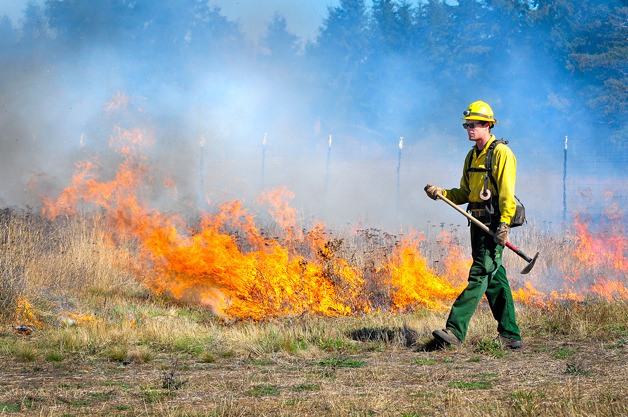To help restore endangered plant life invaded by non-native species, a controlled burn of prairie land was conducted last Thursday at the Pacific Rim Institute for Environmental Stewardship.
The blaze was set and managed by Washington State Department of Natural Resources and the Institute, located just south of Coupeville.
“There used to be more than 8,000 acres of native prairie land on the island, and today only a small patch of four and half acres of native prairie exists on Whidbey,” explained Joe Sheldon, who holds a Ph.D. in insect ecology with a focus on conservation biology.
Sheldon said that the patch of land is exactly what was here more than 12,000 years ago after the glaciers retreated, creating Puget Sound.
He said it has nearly all been lost due to development.
“Sure if you look over there, that looks like prairie, and functions like prairie, but not a single one of all the plant life over there is native to this land,” Sheldon said.
According to the Pacific Rim Institute and Sheldon, the prairie land on Central Whidbey is among the most endangered ecosystems in Washington state.
The goal is to burn out the non-native plants and revitalize the natural prairie ecosystem, they said.
“To the native insects, the prairie that we see may look fine, but to an insect it might as well be barren wasteland,” Sheldon said. “You have to have the habitat to protect and ensure the survival of endangered species.”
Sheldon said that Native Americans who inhabited Whidbey for centuries understood the importance of using fire to manage prairie lands.
“Fire is essential to complete the circle of life, and plants depend on that, he said. “The fire enriches the soil and the smoke enhances seed germination.”
The Pacific Rim Institute routinely collects seeds from a native patch found on the prairie to replant after the non-native species have been destroyed.
More than 60 different species of plant life were collected from endangered prairie plants prior to the burn.
One particularly endangered plant on the island is the Golden Paintbrush.
According to the Washington Native Plant Society, plants do not receive the same protection under conservation law and policy that animals do and are only protected on federal lands.
Extinction of a single plant species may result in the disappearance of up to 30 other species of plants, according to the United States Forest Service.
“We want to bring the full blown natural prairie back and protect one of Washington’s rarest ecosystems,” Sheldon said.

Golden Paintbrush
(Castilleja levisecta) is relatively short-lived, with individual plants only surviving five to six years. It tends to grow in clumps from one to 15 stems to about 12 inches tall and reproduce only through seed. It is covered with soft, sticky hairs. Currently, nine populations are known to exist in Washington state, more than half on Whidbey and the San Juan islands. Plants emerge as early as February and are observed into summer.
Source: Fish and Wildlife Service


